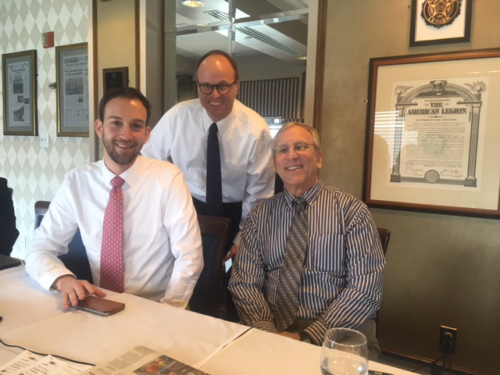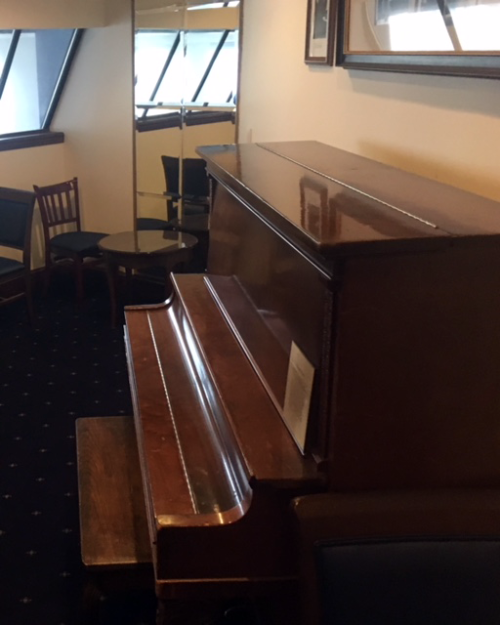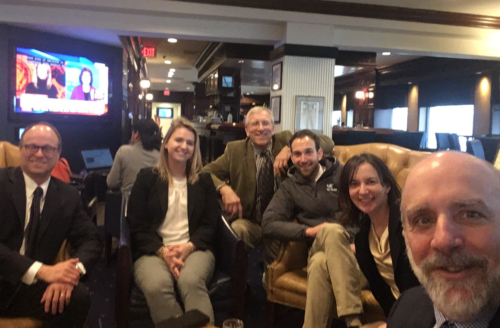Visiting the National Press Club to talk about Chesapeake Bay
Bill Dennison ·Our Proceedings of the National Academy of Sciences paper entitled “Long-term nutrient reductions lead to the unprecedented recovery of a temperate coastal region” was published online on March 5th, 2018. Coinciding with the paper publication, 4 of the 14 co-authors joined Mike Smith from GreenSmith at the National Press Club in Washington, D.C. for a series of interviews with the media. Jon Lefcheck flew down from Maine where he is currently based, Bob “JJ” Orth drove up from Virginia, and Jeni Keisman and I traveled from our respective Maryland homes. Mike organized a series of media interviews at the National Press Club in the McClendon Room, named for Sarah McClendon, a long time White House reporter.

We saw the ‘Truman Piano’ and a photograph of the piano being played in February, 1945 by then Vice President Harry Truman with the actress Lauren Bacall sitting atop the piano. Later that same year, Truman succeeded to the presidency after the death of Franklin D. Roosevelt. We also saw the large ballroom where the famous National Press Club luncheons take place. Reporters sat at study carrels. Mike spotted a U.S. Senator and a former U.S. Congressman visiting. We celebrated the end of the interviews with a beer at the bar, so we felt as though we had the full National Press Club experience.




We were impressed with the quality of the questions asked by the reporters. Three of the questions were particularly interesting, and I drafted some bulleted responses to those questions.
1) What is special about Chesapeake Bay that ecosystem restoration is occurring here, but not in many other locations?
- The Chesapeake region is relatively wealthy. The primary Chesapeake Bay watershed states are relatively wealthy, according to 24/7 Wall St. using 2016 survey data. Maryland (1), Virginia (8) and Pennsylvania (21) are highly ranked out of the 50 U.S. states. This wealth has been used to create funding mechanisms for ecosystem restoration (e.g., sewage treatment upgrades and incentivizing farmers to reduce pollution in runoff). Federal dollars invested in the program are effectively leveraged by the watershed states, local municipalities and community groups.
- Chesapeake Bay has a long history of high quality research and comprehensive monitoring. Thus, we have access to excellent time course data sets that allowed us to discern trends and the causal relationships behind the trends. The degradation and recoveries in other locations outside of the Chesapeake may go undetected.
- The Chesapeake Bay is an effective multi-jurisdictional, multi-faceted partnership, facilitated by the U.S. Environmental Protection Agency. This partnership insures that the restoration funds are strategically utilized, and that the research and monitoring is rigorous and coordinated.
- The importance of Chesapeake Bay restoration has been a bipartisan issue since the inception of the Chesapeake Bay Program. Political leaders from both major parties have embraced the Bay, albeit with different approaches to achieving the common goal of restoring the Bay.
2) How have relatively small changes in nutrient loading accounted for massive increases in the underwater grasses?
- We call the underwater grasses our “coastal canaries.” Like the canaries in the coal mine, we see them as sensitive sentinels. When they are affected, it is a sign that something is amiss. But they can also serve as harbingers of good things to come in terms of ecosystem health. Their sensitivity makes them susceptible to both declines and recoveries.
- The influence of nutrients on ecosystems is multifaceted. Nutrients undergo many transitions and are tightly cycled within ecosystems, so small amounts of nutrients can have a disproportionate influence on the overall ecosystem health. The “nutrient cascade” through the food web means that nutrients can have profound effects on ecosystem.
- Chesapeake Bay is very broad and shallow, providing vast areas of the Bay bottom that are potential habitat for the different species of underwater grasses. A small change in light availability (mediated by nutrient loading and subsequent algal growth that compete with underwater grasses) can result in massive areas of Bay bottom available for underwater grass colonization.
3) This seems awfully convenient that this study is coming out just when the Chesapeake Bay Program funding is under attack. Did you plan this?
- We initiated this scientific synthesis without a clear goal of what we wanted to find. We only knew that we wanted to better understand the changes in nature that we were observing. We did not know that our results would end up as they did.
- The Chesapeake Bay Program was launched under the Reagan administration. We initiated this synthesis effort in 2016 under the Obama administration and we are reporting our results under the Trump administration. We did not foresee the results of the 2017 election when our synthesis effort was initiated.
- We do support the Chesapeake Bay Program as an effective means for insuring high quality monitoring, coordinated research efforts and targeted implementation. We are strong advocates for high quality science but we are happy to leave the politics to the NGOs and the government so that we can tackle the scientific issues.
One of the reporters we spoke with was Ariel Wittenberg from E&E News and Greenwire. Ariel summarized what we were saying about the recovery of Chesapeake Bay as a potential model for other estuaries with the line “If I can make it there, I can make it anywhere.” This prompted me to write the following song, based on “New York, New York”:
Chesapeake, Chesapeake
6 March 2018
Chesapeake, Chesapeake
Start spreading the news
We’re talkin’ today
I want to be a part of it, Chesapeake, Chesapeake
Your aquatic grasses, they are rebounding in the Bay
And they are the heart of it, Chesapeake Bay, Chesapeake Bay
I wanna wake up on a Bay, where the grasses grow deep
And find your Bay getting better, top of the heap
Your Chesapeake blues, they’re melting away
Let’s make a brand new start of it, in Chesapeake Bay
If you can make it there, you can make it anywhere, in Chesapeake Bay
It’s up to you Chesapeake, Chesapeake
Chesapeake, Chesapeake
I wanna wake up on a Bay, where the grasses grow deep
And find we’re king of the hill and top of the heap
A number one
These Chesapeake blues, are melting away
We’re gonna make a brand new start of it
Right here in Chesapeake
If you can make it there, you can make it anywhere
Come on! Chesapeake, Chesapeake
Chesapeake!
About the author
Bill Dennison

Dr. Bill Dennison is a Professor of Marine Science and Vice President for Science Application at the University of Maryland Center for Environmental Science.

